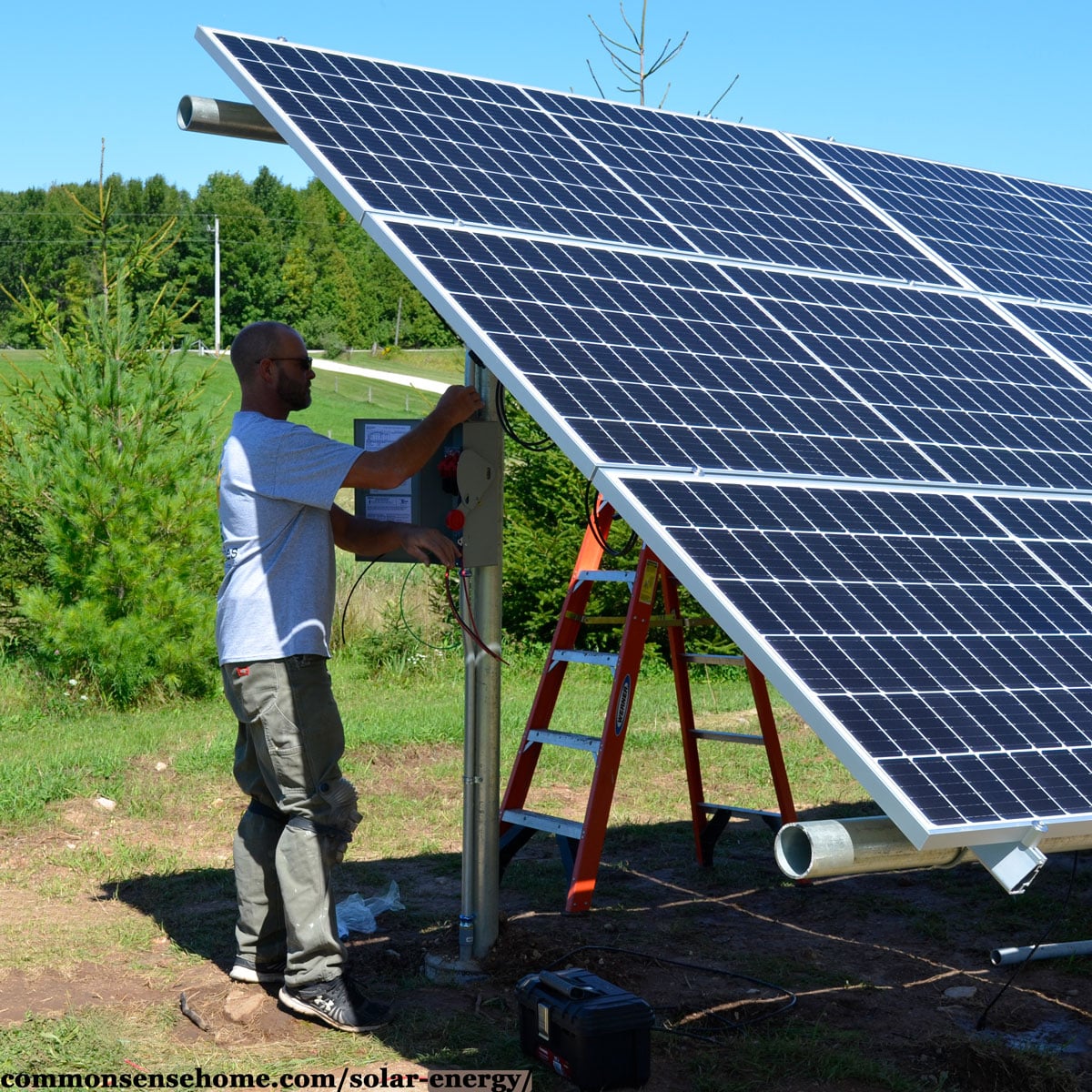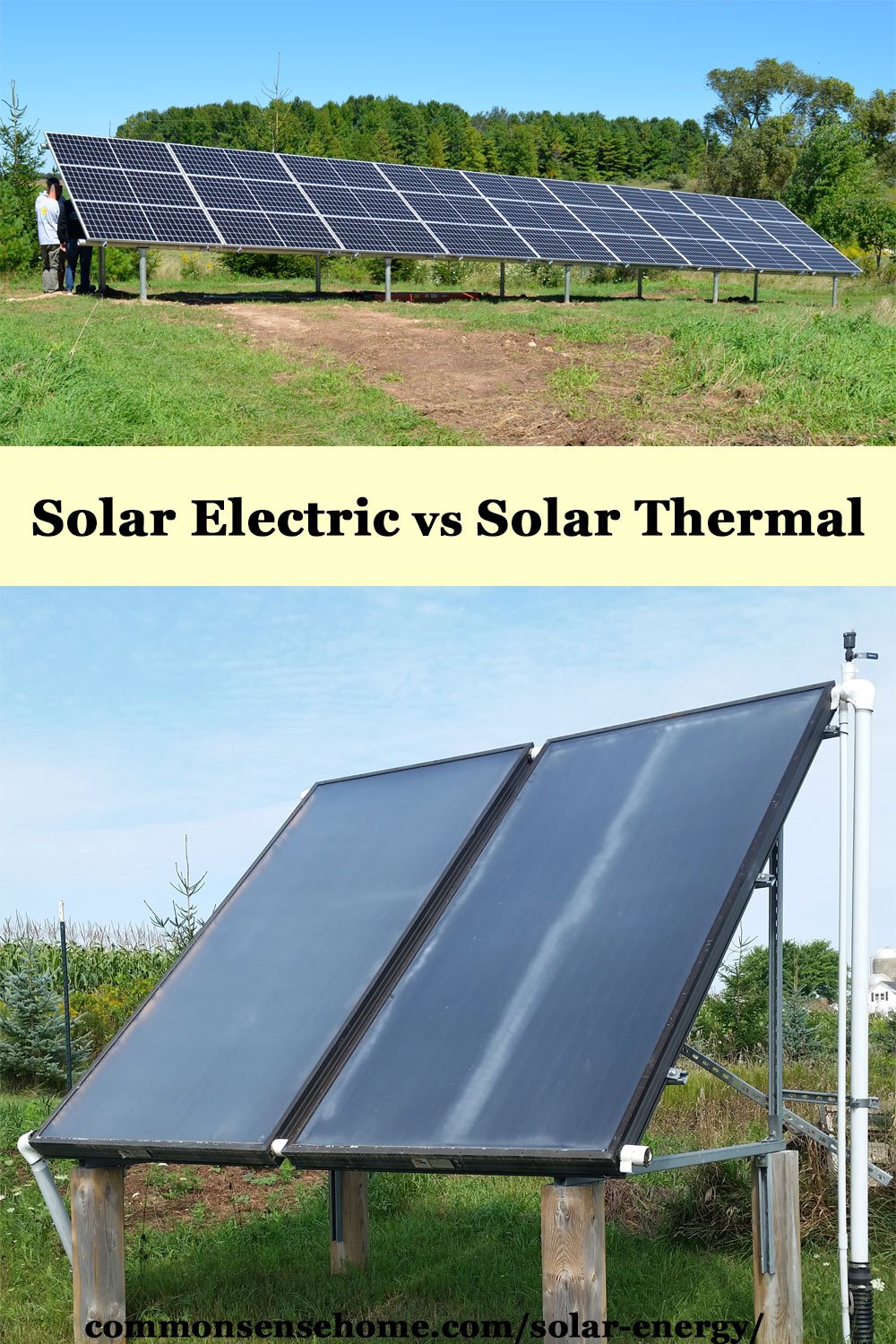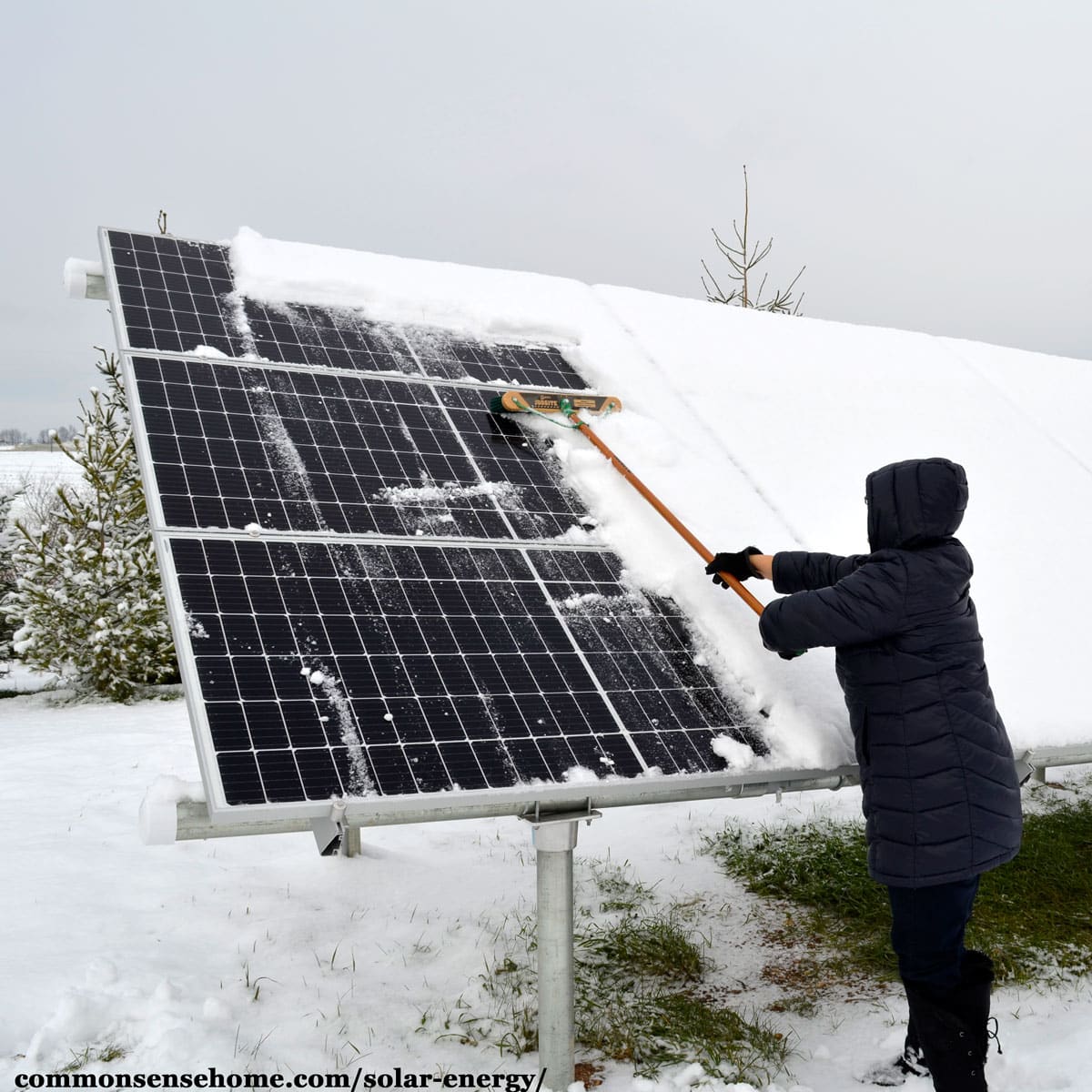Solar Energy Questions and Answers, Pros and Cons
This post may contain affiliate links. Read my full disclosure here.
To help our readers get more familiar with solar, we’re putting together a series of articles answering common solar energy questions. First up, basic information on how solar energy works and pros and cons of solar. The next posts in the series will cover costs, sizing and installation.

Table of contents
What is solar energy?
Solar energy is energy that comes from the sun. We use it in our homes for solar heating, hot water, daylighting and electricity production.
Solar electric systems, also known as photovoltaic (PV for short), convert sunlight to electricity. Solar thermal systems make heat for space and water heating.
PV panels make energy using silicon wafers similar to computer chips. Sunlight hits the panel, electrons get moving and produce power. This only happens in measurable amounts with the right combination of materials. (Glass is made from silicon, too, but your glass of water isn’t going to power your home.)
Why is solar so expensive?
The special combination of materials in solar panels is what makes them so expensive. In the right conditions, silicon forms into crystals. For solar panels, silicon is mixed with small amounts of other elements, such as phosphorus and gallium. (See “How Solar Panels Work” for more information.)
Solar manufacturers grow large crystals and carefully cut them into thin wafers with lasers. These wafers are assembled into panels, each carefully connected to the wafer next to it. The whole unit is built inside a sturdy frame, covered with durable glass for long life. The process is delicate and labor intensive, thus the high cost.
Can I get solar panels for free?
No, there are no free solar energy panels – BUT – some utilities partner with their customers to offer low cost panels or to spread payments out over several years.
There are also federal tax credits and some state incentives, which we’ll discuss in the post about cost. In some cases, especially for businesses, there may be grants available to help cover installation costs.
Can I get heat and electricity from the same solar panels?
It’s not a good idea to try and combine both types of solar energy collection in one panel. With solar thermal energy systems, you want high temperatures for your water or space heating. Solar electric panels are most efficient in cooler temperatures. If they get too hot, energy production decreases, even in full sun.
This is one of the reasons PV panels do well in colder climates, even with less sun. In addition, the panels also gather some energy from the sunlight reflected off of snow.
Do I need batteries for my solar energy system?
Solar panels make power when they are exposed to sunlight. This means that you won’t have power at night from your solar power system so you will need batteries or a generator. Most people work around this by connecting their systems to the utility grid, pulling power as needed.
Unfortunately, as many people in California have found with this year’s widespread power outages, grid connected solar energy systems don’t work when the power is out.
To protect utility lineman working on the power lines, Underwriters Laboratories requires that all grid connected inverters automatically disconnect from the utility grid if they sense an outage.
Electric utilities have sensors scattered among their distribution network. When they sense an outage, utilities dispatch crews to fix the problem. If you are generating electricity and feeding power to the grid, it can confuse the sensors and delay the repair crews. Even a small amount of power can be dangerous to lineman.
To have power during an outage, you MUST have a system with batteries (or a generator)!
How many solar panels are needed to power a house?
To determine how many panels you need, you first need to figure out your electric use. You can check your electric bill to figure out your “electric load”. The higher your use, the more solar panels (power) you will needed. It’s far more cost effective to reduce your energy use up front than to add extra panels to cover excessive use. We recommend a “max” size for a solar array is 7kw (7000 watts) because most home inverters are optimized to be 7kw or smaller. If you want to go bigger be careful.
How long will solar panels last?
Panels will last 15 to 30 years depending on the type of panel. All panels degrade about .8% or .9% per year. So the normal solution is to slightly overbuild the capacity of the system.
Would you like to save this?
What angle should I mount my solar panels?
You also want to look at your mounting angle, the industry calls this the “solar angle of incidence”. What’s the slope of the roof (for roof mounted systems)? Does your roof face due south (in the northern hemisphere)? Do you get any shading in the area where you want to install your solar panels?
Ideally, you want your panels to face within +/- 10° of true south, and a tilt angle close to your latitude angle. (More on this in sizing and installation posts.)
Our system has 27 panels, but we are home almost all day, every day, so our load is heavier than some.
What are some good things about solar energy?
Home power production. Small scale solar electric installations are one of the easiest and most practical ways for homeowners to produce their own electricity.
Backup Power. Our utility grid is aging. Short and long term power outages are becoming more common. With enough solar panels, you can make your own power plant, if you have batteries.
Solar energy is abundant. Even here in chilly Wisconsin, we have sun. Odds are the sun will be around for over 6 billion years, so we won’t run out any time soon.
Solar provides power where the grid can’t reach. In situations where extending power lines is cost prohibitive, solar powered electricity brings light to the darkness.
Solar panels are low maintenance. A fixed solar array has no moving parts. With the new lithium ion batteries, the only regular maintenance is keeping the panels and battery covers clean.
Solar energy can save you money. Once installed, solar power reduces or eliminates your electric bill. Where rates are high, the money saved adds up more quickly, reducing payback time. Tax credits and other incentives can also speed payback time.
What are the bad things about solar energy?
Cost – The biggest issue most people have with solar energy is the installation cost. The Average cost of an installed 10kw solar system is over $20,000. Add battery backup, and you easily double the price.
Clearing the panels – Even though there are no moving parts, the cells must have to have direct sunlight. So in northern climates that means cleaning the panels off.
Lack of sunlight – The sun doesn’t always shine, so if you want power on cloudy days or at night, you need to be grid connected or have battery or generator backup.
Only so much energy available – The most efficient panels only convert about 20% of available sunlight to energy. If you want more energy, you need more panels. Concentrated energy production methods such as nuclear power plants produce a much larger amount of energy in much less space.
Complexity – You or your trusted installer need to know a lot about your power load and your electrical panels.
Solar panels degrade over time – The amount of power they create decreases over time. About 0.8% to 0.9% decrease each year. This means in year one you get 100% and year two will be about 99.1%. Year 5 will be about 95%, year 10 will be about 91% and year 15 will be 87%. These numbers will vary depending on the panel type, heat exposure and other variables. Battery life will vary also.
Waste and pollution – At this time, solar panels aren’t recycled. Panel production also produces toxic waste, and the panels themselves may release contaminants via rainwater exposure. We put our array where there would be no food crops.
The article “If Solar Panels Are So Clean, Why Do They Produce So Much Toxic Waste?” notes:
The International Renewable Energy Agency (IRENA) in 2016 estimated there was about 250,000 metric tonnes of solar panel waste in the world at the end of that year. IRENA projected that this amount could reach 78 million metric tonnes by 2050.
Solar panels often contain lead, cadmium, and other toxic chemicals that cannot be removed without breaking apart the entire panel.
Solar energy is often referred to as “clean energy”, but like every energy source, it comes with an environmental cost. Right now the solar industry is passing those costs into the future.
If you have specific questions about solar, or experience you’d like to share, please leave a comment below.
Related Articles

This post was written by August Neverman IV. August has a strong background in emergency preparedness. He served on several emergency preparedness teams during his tenure at Brown County WI Government, the Medical College of Wisconsin, HSHS, a 13-hospital system and emergency response training during his time with the Air Force and Air National Guard. Learn more about August.





I want to add solar power to charge an EV, however I will be moving (due to retirement) in around three years so I need to buy a system that I can transfer to a new property. Is this possible? are there systems out there that allow you to move them without costing an arm and a leg?
Standard home systems are firmly anchored to prevent wind damage, but there are other options. It really depends on your load and long term goals.
There are smaller systems that are designed for RVs, portable emergency solar generators, and big old trailer mounted roll out emergency panels.
You probably don’t want to roof mount panels at your current location and attempt to relocate them. Too much risk of roof damage, on top of all the labor involved and leaving the roof looking like an eyesore after the panels are gone. A typical ground mount system would also leave an eye sore behind if you moved the panels when you moved – unless you set it up as part of a roof structure and replaced the panels with roofing when you moved.
Search on “large scale portable solar system” to get an idea of some of the products currently on the market. Check your electric bills (or charging goals) to get an idea of the size of system that you would need.
August, I am definitely looking forward to the upcoming articles in this series!
You hit the nail on the head mentioning how the folks in CA ‘thought’ they would have power during their outages. It all depends on if your solar is grid tied or not.
We are experimenting with a small solar array, obviously battery tied. Won’t power everything, but we are okay with that. I hope you will discuss best/okay/worst batteries to rely on for a system. As well as the size array and battery system one might need to power specific items.
I’d also be interested in your opinion on the ‘cheap’ smaller systems available via places like Harbor Frieght vs spending the bigger bucks.(I know, you get what you pay for…but I don’t have 20G to invest in a system off the top, can I realistically build a reliable system?)
Thanks for the feedback. We’ll reach out to our contacts in the solar industry and see what we can pull together. The first articles will be on the bigger systems, but those are questions I’m sure many people have, so I appreciate you bringing them up.